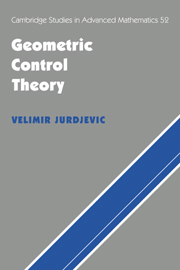Part one - Reachable sets and controllability
Published online by Cambridge University Press: 07 October 2009
Summary
For the purposes of this book, a “control system” is any system of differential equations in which control functions appear as parameters. Our qualitative theory of control systems begins with the important geometric observation that each control determines a vector field, and therefore a control system can also be viewed as a family of vector fields parametrized by controls. A trajectory of such a system is a continuous curve made up of finitely many segments of integral curves of vector fields in the family.
This geometric view of control systems fits closely the theoretical framework of Sophus Lie for integration of differential equations and points to the non-commutativity of vector fields as a fundamental issue of control theory. The geometric context quickly reveals the Lie bracket as the basic theoretical tool, and the corresponding theory, known as geometric control theory, becomes a subject intimately connected with the structural properties of the enveloping Lie algebras and their integral manifolds. For this reason, our treatment of the subject begins with differentiable manifolds, rather than with ℝn as is customary in the control-theory literature.
As natural a beginning as it may seem, particularly to the reader already familiar with differential geometry, this point of view is a departure from the usual presentation of control theory, which traditionally has been confined either to linear theory and the use of linear algebra or to control systems in ℝn, with an emphasis on optimality. The absence of geometric considerations and explicit mention of the Lie bracket in this literature can be attributed to the historical development of the subject.
- Type
- Chapter
- Information
- Geometric Control Theory , pp. 1 - 2Publisher: Cambridge University PressPrint publication year: 1996

